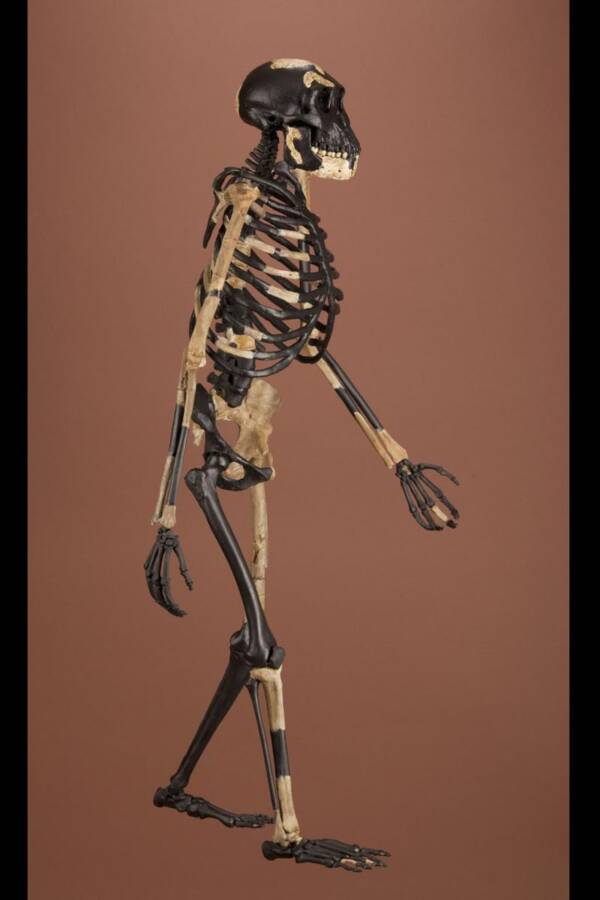The discovery suggests that two bipedal hominin — and not one as previously believed — roamed the Earth at the same time.

Jeremy DeSilvaThis footprint was preserved by volcanic ash and mud for 3.7 million years.
In 1976, paleontologists found two sets of footprints dating back 3.7 million years. One appeared to be the oldest known evidence of upright walking among early humans; the other appeared to belong to a bear. But scientists now think the second pair of footprints belonged to humans, too.
That footprint, scientists believe, may be evidence of a previously unknown human ancestor. If so, then two bipedal humans — not one, as previously believed — roamed the earth at the same time.
“These footprints demonstrate that the evolution of upright walking was more complicated and more interesting than we previously thought,” explained Jeremy DeSilva, an anthropology professor at Dartmouth College and the co-author of a recent study of the footprint published in Nature.
“There were at least two hominins, walking in different ways, on differently shaped feet, at this time in our evolutionary history, showing that the acquisition of human-like walking was less linear than many imagine.”
Previously, scientists believed only one species of human lived at the time — Australopithecus afarensis who roamed ancient Africa 3.9 to 2.9 million years ago. Lucy the skeleton is a famous example of Australopithecus afarensis.

Smithsonian Museum of Natural HistoryLucy the skeleton is the most famous example of Australopithecus afarensis.
But the second pair of footprints seem to belong to a different kind of human, with a peculiar way of walking. Instead of walking in a straight line, the footprints suggest they swung their foot forward and landed it in front of the other.
Remarkably, scientists suspect that both early humans crossed the site of Laetoli in northern Tanzania around the same time. Following a volcanic eruption, they picked their way across ash turned to mud.
At some point, mused Ellison McNutt, a biological anthropologist at Ohio University’s Heritage College of Osteopathic Medicine, the two early humans may have caught a glimpse of each other.
She suggested that the mysterious owner of the second pair of footprints could have “looked up across the landscape and saw an Australopithecus afarensis walking somewhere else.”
McNutt added: “It’s really cool that we may have two hominin species, at least, living at the same place.”
Following this possible encounter, the volcano erupted again. A new layer of ash covered the footprints in Laetoli and preserved them for millions of years. But it took much longer for researchers to untangle their significance.

Tim Evanson/Wikimedia CommonsA cast of the Laetoli footprints at the Smithsonian.
In 1976, paleontologists found the Australopithecus afarensis prints at Laetoli site G. These, they determined, were the earliest known footprints left by bipedal humans. They also found footprints at Laetoli site A, but couldn’t determine if they were left by a bear or by man.
“Scientists were not convinced by either explanation,” explained Stephanie Melillo, a paleoanthropologist at the Max Plank Institute for Evolutionary Anthropology. “Ultimately, the site A prints were more easily forgotten than explained.”
It wasn’t until recently that DeSilva and his team set out to find and reexamine the footprints at Laetoli site A. After excavating the site anew, he and his team also studied how bears walked — and found that they walk on two feet just 1 percent of the time.
Thus, it’s more likely that the footprints at Laetoli site A belonged to an early species of man, not an ancient bear.
The “site A footprints are unlike those of any other hominin,” explained Melillo, who said that DeSilva’s team did a “convincing job” of proving the prints didn’t belong to a bear.
“The footprints themselves are oddly wide and short, and the feet responsible for their creation might have had a big toe that was capable of thumb-like grasping, similar to the big toe of apes.”
And if they do belong to early man, then the prints challenge previously held assumptions about the course of early human history.
“If it’s the case that this is a second species, this discovery shows that Australopithecus afarensis and something else were really in the same time, at the same place,” said Meillo.
For now, this mysterious human ancestor remains an enigma. Though DeSilva suggested that it stood just three feet tall, only fossil evidence can provide further insights on what this early human looked like.
After learning about the footprints that may belong to a new human ancestor, read about the people in West Africa with DNA that doesn’t link to anyone known human ancestor. Or, discover the story of Ikaria Wariootia, the fossil believed to be the ancestor of all known animals.





